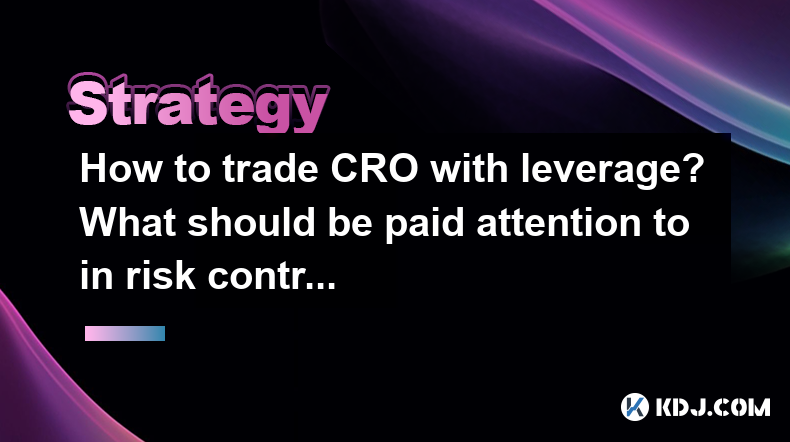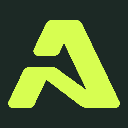-
 bitcoin
bitcoin $112715.707551 USD
-1.71% -
 ethereum
ethereum $4101.475385 USD
-3.01% -
 tether
tether $1.000644 USD
-0.02% -
 bnb
bnb $1207.619465 USD
-6.77% -
 xrp
xrp $2.501451 USD
-3.98% -
 solana
solana $202.947124 USD
-3.32% -
 usd-coin
usd-coin $1.000295 USD
0.04% -
 dogecoin
dogecoin $0.203884 USD
-4.47% -
 tron
tron $0.317154 USD
-1.72% -
 cardano
cardano $0.695009 USD
-4.43% -
 hyperliquid
hyperliquid $38.853961 USD
-8.23% -
 chainlink
chainlink $18.988674 USD
-4.64% -
 ethena-usde
ethena-usde $1.000233 USD
-0.03% -
 stellar
stellar $0.337050 USD
-3.63% -
 bitcoin-cash
bitcoin-cash $536.861728 USD
-1.28%
How to trade CRO with leverage? What should be paid attention to in risk control?
Trading CRO with leverage can amplify profits and losses; use stop-loss orders and manage leverage wisely to mitigate risks effectively.
May 01, 2025 at 06:42 pm

Trading CRO (Crypto.com Coin) with leverage can be an exciting yet risky endeavor. Leverage allows traders to amplify their exposure to the market, potentially increasing both profits and losses. In this article, we will explore how to trade CRO with leverage, and what crucial aspects of risk control should be considered.
Understanding Leverage in Crypto Trading
Leverage in cryptocurrency trading refers to the use of borrowed funds to increase the potential return of an investment. When trading CRO with leverage, you can control a larger position than your actual capital would allow. For instance, if you have $1,000 and use 10x leverage, you can control a $10,000 position. However, this also means that any market movement, whether positive or negative, will be magnified by the same factor.
To start trading CRO with leverage, you need to choose a platform that supports leveraged trading. Some popular exchanges that offer this feature include Binance, Bybit, and FTX. Each platform may have different leverage options and margin requirements, so it's important to research and compare before deciding.
Steps to Trade CRO with Leverage
To begin trading CRO with leverage, follow these detailed steps:
- Choose a Trading Platform: Select a reputable exchange that offers leveraged trading for CRO. Ensure the platform is secure and has a user-friendly interface.
- Create and Verify an Account: Sign up for an account on the chosen platform. Complete the verification process, which typically involves submitting personal identification documents.
- Deposit Funds: Fund your account with the necessary capital. Most platforms support deposits via bank transfer, credit/debit cards, or other cryptocurrencies.
- Navigate to the CRO Trading Section: Find the section of the platform where CRO trading is available. This is usually under the 'Futures' or 'Margin' trading section.
- Select Leverage: Choose the desired leverage level. Common options include 2x, 5x, 10x, or even higher. Be cautious as higher leverage increases risk.
- Place an Order: Decide whether you want to go long (buy) or short (sell) CRO. Enter the amount you wish to trade and confirm the order.
- Monitor and Manage Your Position: Keep a close eye on your position. Use stop-loss and take-profit orders to manage risk and secure profits.
Key Aspects of Risk Control in Leveraged Trading
When trading CRO with leverage, risk control is paramount. Here are some essential aspects to consider:
- Use Stop-Loss Orders: A stop-loss order automatically closes your position when the price reaches a certain level, limiting potential losses. For example, if you buy CRO at $0.10 with 10x leverage, setting a stop-loss at $0.09 can help minimize losses if the price drops.
- Set Take-Profit Orders: Similarly, a take-profit order closes your position when the price reaches a profitable level. This ensures you lock in gains before the market reverses.
- Manage Leverage Wisely: Higher leverage can lead to higher profits, but it also increases the risk of liquidation. Start with lower leverage until you gain more experience.
- Diversify Your Portfolio: Don't put all your capital into one leveraged position. Diversifying across different assets can help mitigate risk.
- Stay Informed: Keep up with market news and trends that could affect CRO's price. Being informed can help you make better trading decisions.
Understanding Liquidation and Margin Calls
Liquidation occurs when the value of your position falls below the maintenance margin requirement, and the exchange closes your position to prevent further losses. To avoid liquidation, you need to maintain sufficient margin in your account.
A margin call is a warning from the exchange that your account is approaching the liquidation level. If you receive a margin call, you have the option to deposit more funds or close part of your position to meet the margin requirements.
Psychological Aspects of Leveraged Trading
Trading with leverage can be emotionally challenging. Emotional discipline is crucial to avoid making impulsive decisions based on fear or greed. Here are some tips to maintain psychological balance:
- Stick to Your Trading Plan: Develop a clear trading plan and adhere to it. This includes entry and exit points, risk management strategies, and profit targets.
- Avoid Overtrading: Don't trade too frequently, as this can lead to burnout and poor decision-making. Take breaks and step away from the screen when needed.
- Accept Losses: Understand that losses are part of trading. Don't let a single loss affect your overall strategy or confidence.
Tools and Indicators for Leveraged Trading
Using the right tools and indicators can enhance your trading strategy. Some popular tools for trading CRO with leverage include:
- Moving Averages: These help identify trends by smoothing out price data over a specific period. For example, a 50-day moving average can indicate the overall direction of CRO's price.
- Relative Strength Index (RSI): This momentum oscillator measures the speed and change of price movements. An RSI above 70 may indicate that CRO is overbought, while below 30 may suggest it's oversold.
- Bollinger Bands: These bands help identify volatility and potential price breakouts. When CRO's price touches the upper band, it might be overbought, and when it touches the lower band, it might be oversold.
Frequently Asked Questions
Q: Can I trade CRO with leverage on any cryptocurrency exchange?A: Not all exchanges offer leveraged trading for CRO. You need to choose a platform that specifically supports this feature, such as Binance, Bybit, or FTX.
Q: What is the maximum leverage I can use when trading CRO?A: The maximum leverage varies by platform. Some exchanges offer up to 100x leverage, but it's crucial to start with lower leverage to manage risk effectively.
Q: How can I calculate the potential profit or loss when trading CRO with leverage?A: To calculate potential profit or loss, consider the leverage used and the price movement of CRO. For example, if you use 10x leverage and CRO's price increases by 1%, your profit would be 10%. Conversely, a 1% drop would result in a 10% loss.
Q: Is it possible to trade CRO with leverage without risking my entire account?A: Yes, by using proper risk management techniques such as stop-loss orders and managing leverage wisely, you can protect your account from significant losses.
Disclaimer:info@kdj.com
The information provided is not trading advice. kdj.com does not assume any responsibility for any investments made based on the information provided in this article. Cryptocurrencies are highly volatile and it is highly recommended that you invest with caution after thorough research!
If you believe that the content used on this website infringes your copyright, please contact us immediately (info@kdj.com) and we will delete it promptly.
- BTC, ETH, and Crypto Presales: Navigating the Storm with MoonBull & LivLive
- 2025-10-15 11:05:13
- BlackRock's Bitcoin ETF Buzz Down Under: Australia's Crypto Scene Heats Up
- 2025-10-15 11:45:15
- Trump, Bitcoin, and Trump Media: A New York Minute on Crypto's Latest Twist
- 2025-10-15 11:05:13
- Altcoin Season Incoming? Historical Setups and Trends to Watch
- 2025-10-15 11:45:15
- Crypto Scam Crackdown: Cambodian Executive, Bitcoin Seizure, and a $14 Billion Heist
- 2025-10-15 11:10:00
- Bitcoin's Wild Ride: Structural Demand Survives the Liquidation Tsunami
- 2025-10-15 11:10:00
Related knowledge

Practical parameter settings for a Bitcoin multi-timeframe moving average system
Sep 18,2025 at 10:54pm
Optimizing Timeframe Combinations for Bitcoin Trading1. Selecting appropriate timeframes is crucial when building a multi-timeframe moving average sys...

How can I filter out false breakouts in Dogecoin high-frequency trading?
Sep 22,2025 at 01:00am
Understanding False Breakouts in Dogecoin Trading1. A false breakout occurs when Dogecoin's price appears to move beyond a defined support or resistan...

Techniques for identifying tops and bottoms in the Bitcoin on-chain NVT model
Sep 20,2025 at 07:54pm
Understanding the NVT Model in Bitcoin Analysis1. The Network Value to Transactions (NVT) ratio is often described as the 'P/E ratio' of the cryptocur...

What does the surge in open interest in Bitcoincoin futures mean?
Sep 20,2025 at 11:18pm
Understanding the Surge in Dogecoin Futures Open Interest1. A surge in open interest within Dogecoin futures indicates a growing number of active cont...

How can I use the Ethereum USDT premium to gauge market sentiment?
Sep 18,2025 at 11:55pm
Understanding the Ethereum USDT Premium1. The Ethereum USDT premium refers to the price difference between USDT (Tether) traded on Ethereum-based plat...

What should I do if Ethereum staking yields decline?
Sep 20,2025 at 06:18am
Understanding the Causes Behind Declining Ethereum Staking Yields1. The Ethereum network transitioned to a proof-of-stake consensus mechanism with the...

Practical parameter settings for a Bitcoin multi-timeframe moving average system
Sep 18,2025 at 10:54pm
Optimizing Timeframe Combinations for Bitcoin Trading1. Selecting appropriate timeframes is crucial when building a multi-timeframe moving average sys...

How can I filter out false breakouts in Dogecoin high-frequency trading?
Sep 22,2025 at 01:00am
Understanding False Breakouts in Dogecoin Trading1. A false breakout occurs when Dogecoin's price appears to move beyond a defined support or resistan...

Techniques for identifying tops and bottoms in the Bitcoin on-chain NVT model
Sep 20,2025 at 07:54pm
Understanding the NVT Model in Bitcoin Analysis1. The Network Value to Transactions (NVT) ratio is often described as the 'P/E ratio' of the cryptocur...

What does the surge in open interest in Bitcoincoin futures mean?
Sep 20,2025 at 11:18pm
Understanding the Surge in Dogecoin Futures Open Interest1. A surge in open interest within Dogecoin futures indicates a growing number of active cont...

How can I use the Ethereum USDT premium to gauge market sentiment?
Sep 18,2025 at 11:55pm
Understanding the Ethereum USDT Premium1. The Ethereum USDT premium refers to the price difference between USDT (Tether) traded on Ethereum-based plat...

What should I do if Ethereum staking yields decline?
Sep 20,2025 at 06:18am
Understanding the Causes Behind Declining Ethereum Staking Yields1. The Ethereum network transitioned to a proof-of-stake consensus mechanism with the...
See all articles


























![Staking ATH: How To Stake $ATH in October 2025 with 523% APY — [Step-By-Step Guide] Staking ATH: How To Stake $ATH in October 2025 with 523% APY — [Step-By-Step Guide]](/uploads/2025/10/15/cryptocurrencies-news/videos/staking-ath-stake-ath-october-apy-stepstep-guide/68eef94d80903_image_500_375.webp)















































